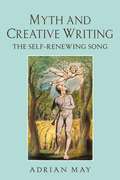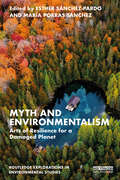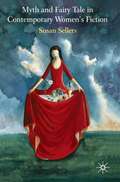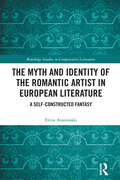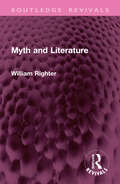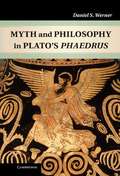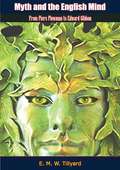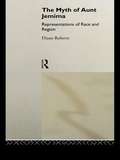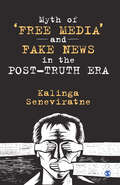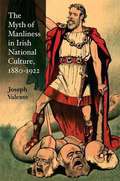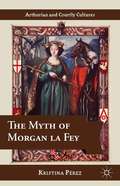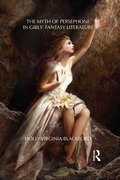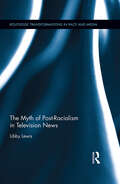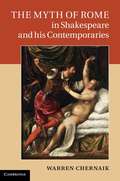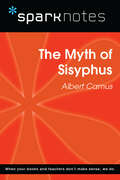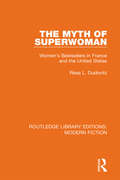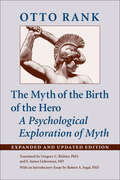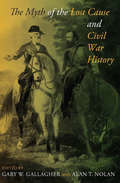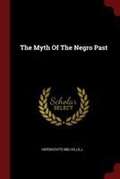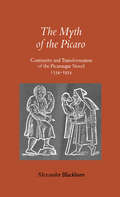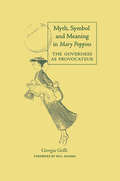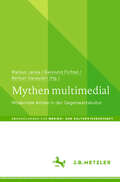- Table View
- List View
Myth and Creative Writing: The Self-Renewing Song
by Adrian MayMyth and Creative Writing is a unique and practical guide to the arts of creative writing. It:Gives a historical perspective on the storyteller's art Takes a wide view of myth, to include: legends, folklore, biblical myth, classical myth, belief myths, balladry and song. Considers all aspects of the creative process, from conception to completion Provides tips on seeking inspiration from classical and mythic sources Shows how myths can be linked to contemporary concerns Enables beginning writers to tap into the deeper resonances of myth Guides students to further critical and creative resourcesA secret that all writers know is that they are part of a long tradition of storytelling - whether they call it mythic, intertextual, interactive or original. And in the pantheon of storytelling, myths (those stories that tell us, in often magical terms, how the world and the creatures in it came to be) are the bedrock, a source of unending inspiration. One can dress the study of literature in the finest critical clothing - or intellectualise it until the cows come home - but at its heart it is nothing more - and nothing less - than the study of the human instinct to tell stories, to order the world into patterns we can more readily understand. Exploring the mythic nature of writing (by considering where the connections between instinct and art are made, and where the writer is also seen as a mythic adventurer) is a way of finding close links to what it is we demand from literature, which is - again - something to do with the essences of human nature. Further, in the course of examining the nature of myth, Adrian May provides a very practical guide to the aspiring writer - whether in a formal course or working alone - on how to write stories (myths) of their own, from how to begin, how to develop and how to close.
Myth and Environmentalism: Arts of Resilience for a Damaged Planet (Routledge Explorations in Environmental Studies)
by Esther Sánchez-Pardo María Porras SánchezThis volume traces the interconnections between myth, environmentalism, narrative, poetry, comics, and innovative artistic practice, using this as a framework through which to examine strategies for repairing our unhealthy relationship with the planet. Challenging late capitalist modes encouraging mindless consumption and the degradation of human–nature relations, this collection advocates a re-evaluation of the ethical relation to "living with" and sharing the Earth. Myth and the environment have shared a rich common cultural history travelling as far back as the times of storytelling and legend, with the environment often the central theme. Following a robust introduction, the book is organized into three main sections—Myth, Disaster, and Present-Day Views on Ecological Damage; Indigenous and Afro-diasporic Myths and Ecological Knowledge; Art Practices, Myth, and Environmental Resilience—and concludes with a Coda from Jeanette Hart-Mann. The methodology draws from diverse perspectives, such as ecocriticism, new materialism, and Anthropocene studies, offering a truly interdisciplinary discussion that reflects on the dialogue among environment and myth, and a broad range of contributions are included from Canada, the United States, the Caribbean, Ukraine, Japan, Morocco, and Brazil. The book joins a long line of approaches on the interrelations between ecological and mythical thinking and criticism that goes back to the early 20th century. This volume will be of interest to students, scholars, activists, and experts in environmental humanities, myth and myth criticism, literature and art on more-than human and nature interaction, ecocriticism, environmental activism, and climate change.
Myth and Fairy Tale in Contemporary Women’s Fiction
by Susan SellersWoman as gorgon, woman as temptress: the classical and biblical mythology which has dominated Western thinking defines women in a variety of patriarchally encoded roles. This study addresses the surprising persistence of mythical influence in contemporary fiction. Opening with the question 'what is myth?', the first section provides a wide-ranging review of mythography. It traces how myths have been perceived and interpreted by such commentators as Sigmund Freud, Carl Jung, Bruno Bettelheim, Roland Barthes, Jack Zipes and Marina Warner. This leads to an examination of the role that mythic narrative plays in social and self formation, drawing on the literary, feminist and psychoanalytic theories of Julia Kristeva, Luce Irigaray, Helene Cixous and Judith Butler to delineate the ways in which women's mythos can transcend the limitations of logos and give rise to potent new models for individual and cultural regeneration. In this light, Susan Sellers offers challenging new readings of a wide range of contemporary women's fiction, including works by A. S. Byatt, Angela Carter, Anne Rice, Michele Roberts, Emma Tennant and Fay Weldon. Topics explored include fairy tale as erotic fiction, new religious writing, vampires and gender-bending, mythic mothers, genre fiction, the still-persuasive paradigm of feminine beauty, and the radical potential of comedy.
The Myth and Identity of the Romantic Artist in European Literature: A Self-Constructed Fantasy (Routledge Studies in Comparative Literature)
by Elena AnastasakiThis study addresses the question of artistic identity and the myth of the artist as it has been shaped by the artists themselves. While the term artist is to be understood in a broad sense, the focus of this study is the literature of the Romantic tradition. Identity is largely perceived as a construct, and a central hypothesis of this book concerns its aesthetic value and the ways it creates dominant narratives of self-perception that produce powerful myths. The construction of the artist’s identity, be it collective or personal, rests on a series of aesthetic praxes. Caught between the mythic idealisation of poetic genius and its social devaluation, the Romantic artist seeks to create a place for himself, and in doing so, he engages in his own mythmaking. This process is studied in an interdisciplinary perspective, approaching texts and writers from different traditions. The study analyses various typologies of the artist, numerous mythmaking strategies as well as several postural techniques; all of which have sketched major direct or indirect fictional self-portraits in the European tradition.
Myth and Literature (Routledge Revivals)
by William RighterFirst published in 1975, Myth and Literature considers three points at which the concept of myth has entered modern literary imagination: the use of myth – or atleast their understanding of myth -- as a creative opening by modern writers, its exploration by critics as an interpretive device, and the analogy between certain ‘sense-making’ functions of ‘myth’, ‘fiction’ and literature itself. All three of these roles show the gradual movement from a point of precise demand to a diffuse and variable concept which is more pervasive because less distinct. The paradox of myth is shown to lie in its simultaneity of its corruption with the growth of its power over the modern literary mind. This book will be of interest to students of literature and history.
Myth and Philosophy in Plato'S Phaedrus
by Daniel S. Werner"Plato's dialogues frequently criticize traditional Greek myth, yet Plato also integrates myth with his writing. Daniel S. Werner confronts this paradox through an in-depth analysis of the Phaedrus, Plato's most mythical dialogue. Werner argues that the myths of the Phaedrus serve several complex functions: they bring nonphilosophers into the philosophical life; they offer a starting point for philosophical inquiry; they unify the dialogue as a literary and dramatic whole; they draw attention to the limits of language and the limits of knowledge; and they allow Plato to co-opt cultural authority as a way of defining and legitimating the practice of philosophy. Platonic myth, as a species of traditional tale, is thus both distinct from philosophical dialectic and similar to it. Ultimately, the most powerful effect of Platonic myth is the way in which it leads readers to participate in Plato's dialogues and to engage in a process of self-examination"--
Myth, literature, and the creation of the topography of Thebes
by Daniel W. BermanHow does a city's legendary past affect its present? Thebes remains a city with one of the richest traditions of myth in all of Greece it was the home of Cadmus, Oedipus, and Hercules, and the traditional birthplace of Dionysus. The city's topography, both natural and built, very often plays a significant role in its myths. By focusing on Greek literature ranging from the oral epics to the travel writing of the Roman Empire, this book explores the relationship between the city's spaces as they were represented in the Greek literary tradition and the physical realities of a developing city that had been continuously inhabited since at least the second millennium BC. Spurred on especially by the city's catastrophic sack by Alexander the Great in 335 BC, the urban topography of Thebes came more and more to reflect the literary, even fictional, constructions of its mythic past. "
The Myth of Aunt Jemima: White Women Representing Black Women
by Diane RobertsThe Myth of Aunt Jemima is a bold and exciting look at the way three centuries of white women writers have tackled the subject of race in both Britain and America. Diane Roberts challenges the widely-held belief that white women writers have simply acquiesed in majority cultural inscriptions of race. The Myth of Aunt Jemima shows how 'the mythic spheres of race, of the separation of black and white into low and high, other and originary, tainted and pure, remain to trouble a society struggling still to free itself from debilitating racial representations.' Beautifully written with a powerful series of textual readings, The Myth of Aunt Jemima pushes at the boundaries of thought around the issues of race and gender. An important and innovative book.
Myth of ‘Free Media’ and Fake News in the Post-Truth Era
by Kalinga SeneviratneMyth of ‘Free Media’ and Fake News in the Post-truth Era reveals the story of ‘fake news’ hysteria and myth of ‘free media’ in the post-truth world order, starting from the question of whether there has really been a ‘truth’ era. The book examines how the news media is battling for relevance in the age of Internet. It shows how the wave of media ‘liberalization’ has weakened the basic premise of Libertarian Media Function Theory, which states that the media is the ‘Fourth Estate’ that protects the citizens from abuse of power by the government. It analyses how excessive commercialization of the media and the commodification of news has changed journalism globally. The book recommends a new paradigm and explains how it can be used to transform news reporting from an adversarial model to a human-centric one.
The Myth of Manliness in Irish National Culture, 1880-1922
by Joseph ValenteThis study aims to supply the first contextually precise account of the male gender anxieties and ambivalences haunting the culture of Irish nationalism in the period between the Act of Union and the founding of the Irish Free State. To this end, Joseph Valente focuses upon the Victorian ethos of manliness or manhood, the specific moral and political logic of which proved crucial to both the translation of British rule into British hegemony and the expression of Irish rebellion as Irish psychomachia. The influential operation of this ideological construct is traced through a wide variety of contexts, including the career of Ireland's dominant Parliamentary leader, Charles Stewart Parnell; the institutions of Irish Revivalism--cultural, educational, journalistic, and literary; the writings of both canonical authors (Yeats, Synge, Gregory, and Joyce) and subcanonical authors (James Stephens, Patrick Pearse, Lennox Robinson); and major political movements of the time, including suffragism, Sinn Fein, Na Fianna E Éireann, and the Volunteers. The construct of manliness remains very much alive today, underpinning the neo-imperialist marriage of ruthless aggression and the sanctities of duty, honor, and sacrifice. Mapping its earlier colonial and postcolonial formations can help us to understand its continuing geopolitical appeal and danger.
The Myth of Morgan La Fey (Arthurian and Courtly Cultures)
by Kristina PérezThe sister of King Arthur goes by many names: sorceress, kingmaker, death-wielder, mother, lover, goddess. The Myth of Morgan la Fey reveals her true identity through a comprehensive investigation of the famed enchantress' evolution - or devolution - over the past millennium and its implications for gender relations today.
The Myth of Persephone in Girls' Fantasy Literature (Children's Literature and Culture)
by Holly BlackfordIn this book, Blackford historicizes the appeal of the Persephone myth in the nineteenth century and traces figurations of Persephone, Demeter, and Hades throughout girls’ literature of the nineteenth and twentieth centuries. She illuminates developmental patterns and anxieties in E. T. A. Hoffmann’s Nutcracker and Mouse King, Louisa May Alcott’s Little Women, Emily Brontë’s Wuthering Heights, J. M. Barrie’s Peter and Wendy, Frances Hodgson Burnett’s The Secret Garden, E. B. White’s Charlotte’s Web, J. K. Rowling’s Harry Potter and the Chamber of Secrets, Stephenie Meyer’s Twilight, and Neil Gaiman’s Coraline. The story of the young goddess’s separation from her mother and abduction into the underworld is, at root, an expression of ambivalence about female development, expressed in the various Neverlands through which female protagonists cycle and negotiate a partial return to earth. The myth conveys the role of female development in the perpetuation and renewal of humankind, coordinating natural and cultural orders through a hieros gamos (fertility coupling) rite. Meanwhile, popular novels such as Twilight and Coraline are paradoxically fresh because they recycle goddesses from myths as old as the seasons. With this book, Blackford offers a consideration of how literature for the young squares with broader canons, how classics flexibly and uniquely speak through novels that enjoy broad appeal, and how female traditions are embedded in novels by both men and women.
The Myth of Piers Plowman
by Lawrence WarnerAddressing the history of the production and reception of the great medieval poem, Piers Plowman, Lawrence Warner reveals the many ways in which scholars, editors and critics over the centuries created their own speculative narratives about the poem, which gradually came to be regarded as factually true. Warner begins by considering the possibility that Langland wrote a romance about a werewolf and bear-suited lovers, and he goes on to explore the methods of the poem's localization, and medieval readers' particular interest in its Latinity. Warner shows that the 'Protestant Piers' was a reaction against the poem's oral mode of transmission, reveals the extensive eighteenth-century textual scholarship on the poem by figures including the maligned Chaucer editor John Urry, and contextualizes its first modernization by a literary forger inspired by the 1790s Shakespeare controversies. This lively account of Piers Plowman challenges the way the poem has traditionally been read and understood.
The Myth of Post-Racialism in Television News (Routledge Transformations in Race and Media)
by Libby LewisThis book explores the written and unwritten requirements Black journalists face in their efforts to get and keep jobs in television news. Informed by interviews with journalists themselves, Lewis examines how raced Black journalists and their journalism organizations process their circumstances and choose to respond to the corporate and institutional constraints they face. She uncovers the social construction and attempted control of "Blackness" in news production and its subversion by Black journalists negotiating issues of objectivity, authority, voice, and appearance along sites of multiple differences of race, gender, and sexuality.
The Myth of Rome in Shakespeare and his Contemporaries
by Warren ChernaikWhen Cleopatra expresses a desire to die 'after the high Roman fashion', acting in accordance with 'what's brave, what's noble', Shakespeare is suggesting that there are certain values that are characteristically Roman. The use of the terms 'Rome' and 'Roman' in Julius Caesar, Antony and Cleopatra, or Jonson's Sejanus often carry the implication that most people fail to live up to this ideal of conduct, that very few Romans are worthy of the name. Chernaik demonstrates how, in these plays, Roman values are held up to critical scrutiny. The plays of Shakespeare, Jonson, Massinger and Chapman often present a much darker image of Rome, as exemplifying barbarism rather than civility. Through a comparative analysis of the Roman plays of Shakespeare and his contemporaries, and including detailed discussion of the classical historians Livy, Tacitus and Plutarch, this study examines the uses of Roman history - 'the myth of Rome' - in Shakespeare's age.
The Myth of Sisyphus (SparkNotes Philosophy Guide)
by SparkNotesThe Myth of Sisyphus (SparkNotes Philosophy Guide) Making the reading experience fun! SparkNotes Philosophy Guides are one-stop guides to the great works of philosophy–masterpieces that stand at the foundations of Western thought. Inside each Philosophy Guide you&’ll find insightful overviews of great philosophical works of the Western world.
The Myth of Superwoman: Women's Bestsellers in France and the United States (Routledge Library Editions: Modern Fiction #15)
by Resa L. DudovitzReviled by critics but loved by the readers, the bestseller has until recently provoked little serious critical interest. In The Myth of Superwoman, originally published in 1990, Resa Dudovitz looks at this international phenomenon, particularly at the origins of the bestseller system in the United States and France. Her cross-cultural study, including interviews with publishers, literary agents, and bestselling authors, gives a lively picture of the contrasting ways in which the bestseller is produced, marketed, and received in two countries. It pays special attention to the ‘international bestsellers’ of the 1980s, to writers like Judith Krantz, Colleen McCullough, and Barbara Taylor Bradford, all of whose novels are published in the United States, Britain, France, Germany, and Italy. The book presents a general analysis of women’s bestsellers, ranging over a wide variety of novels, from popular nineteenth-century texts in France and the United States to the novels of today. Dudovitz shows how women’s bestselling fiction has, over the last two hundred years, kept pace with the social evolution of contemporary women, culminating in the myth of superwoman in women’s bestsellers of the 1980s. This fascinating account of an important aspect of popular culture will be of great value to students of women’s studies and cultural studies, especially those interested in the myths which structure women’s bestselling fiction.
The Myth of the Birth of the Hero: A Psychological Exploration of Myth
by Otto RankFirst published in German in 1909, Otto Rank's original The Myth of the Birth of the Hero offered psychoanalytical interpretations of mythological stories as a means of understanding the human psyche. Like his mentor Sigmund Freud, Rank compared the myths of such figures as Oedipus, Moses, and Sargon with common dreams, seeing in both a symbolic fulfillment of repressed desire. In a new edition published thirteen years after the original, Rank doubled the size of his seminal work, incorporating new discoveries in psychoanalysis, mythology, and ethnology. This expanded and updated edition has been eloquently translated by Gregory C. Richter and E. James Lieberman and includes an introductory essay by Robert A. Segal as well as Otto Rank's 1914 essay "The Play in Hamlet."
The Myth of the Lost Cause and Civil War History
by Gary W. Gallagher and Alan T. Nolan, EditorsA &“well-reasoned and timely&” (Booklist) essay collection interrogates the Lost Cause myth in Civil War historiography. Was the Confederacy doomed from the start in its struggle against the superior might of the Union? Did its forces fight heroically against all odds for the cause of states&’ rights? In reality, these suggestions are an elaborate and intentional effort on the part of Southerners to rationalize the secession and the war itself. Unfortunately, skillful propagandists have been so successful in promoting this romanticized view that the Lost Cause has assumed a life of its own. Misrepresenting the war&’s true origins and its actual course, the myth of the Lost Cause distorts our national memory. In The Myth of the Lost Cause and Civil War History, nine historians describe and analyze the Lost Cause, identifying ways in which it falsifies history—creating a volume that makes a significant contribution to Civil War historiography. &“The Lost Cause . . . is a tangible and influential phenomenon in American culture and this book provides an excellent source for anyone seeking to explore its various dimensions.&” —Southern Historian
The Myth of the Negro Past
by Melville J HerskovitsAlmost fifty years ago Melville Herskovits set out to debunk the myth that black Americans have no cultural past. Originally published in 1941, his unprecedented study of black history and culture recovered a rich African heritage in religious and secular life, the language and arts of the Americas.
The Myth of the Picaro: Continuity and Transformation of the Picaresque Novel, 1554-1954
by Alexander BlackburnThis critical interpretation of the origins of modern fiction follows the transformation of the picaresque novel over four centuries through the literature of Spain, France, England, Germany, Russia, and the United States. Blackburn uses for the first time the resources of myth criticism to demonstrate how the picaresque masterpieces of the Spanish Golden Age founded a narrative structure that was continued by Defoe, Smollett, Melville, Twain, and Mann.Originally published in 1979.A UNC Press Enduring Edition -- UNC Press Enduring Editions use the latest in digital technology to make available again books from our distinguished backlist that were previously out of print. These editions are published unaltered from the original, and are presented in affordable paperback formats, bringing readers both historical and cultural value.
Myth, Ritual, and the Warrior in Roman and Indo-European Antiquity
by Roger D. WoodardThis book examines the figure of the returning warrior as depicted in the myths of several ancient and medieval Indo-European cultures. In these cultures, the returning warrior was often portrayed as a figure rendered dysfunctionally destructive or isolationist by the horrors of combat. This mythic portrayal of the returned warrior is consistent with modern studies of similar behavior among soldiers returning from war. Roger Woodard's research identifies a common origin of these myths in the ancestral proto-Indo-European culture, in which rites were enacted to enable warriors to reintegrate themselves as functional members of society. He also compares the Italic, Indo-Iranian, and Celtic mythic traditions surrounding the warrior, paying particular attention to Roman myth and ritual, notably to the etiologies and rites of the July festivals of the Poplifugia and Nonae Caprotinae, and to the October rites of the Sororium Tigillum.
Myth, Symbol, and Meaning in Mary Poppins: The Governess As Provocateur (Children's Literature and Culture #41)
by Giorgia GrilliThe Mary Poppins that many people know of today--a stern, but sweet, loveable, and reassuring British nanny--is a far cry from the character created by Pamela Lyndon Travers in the 1930's. Instead, this is the Mary Poppins reinvented by Disney in the eponymous movie. This book sheds light on the original Mary Poppins, Myth, Symbol, and Meaning in Mary Poppins is the only full-length study that covers all the Mary Poppins books, exposing just how subversive the pre-Disney Mary Poppins character truly was. Drawing important parallels between the character and the life of her creator, who worked as a governess herself, Grilli reveals the ways in which Mary Poppins came to unsettle the rigid and rigorous rules of Victorian and Edwardian society that most governesses embodied, taught, and passed on to their charges.
Mythen multimedial: Modernste Antike in der Gegenwartskultur (Abhandlungen zur Medien- und Kulturwissenschaft)
by Markus Janka Raimund Fichtel Berkan SariaydinEtwa seit der Jahrtausendwende ist ein internationaler und nach wie vor anhaltender Boom von Adaptionen der griechisch-römischen Mythologie und Historie zu verzeichnen. Dieser ist durch eine bemerkenswerte mediale Vielfalt und Vernetzungsfreude gekennzeichnet. Folglich erstreckt sich die „modernste Antike“ unserer Zeit nicht nur auf hochliterarische Texte oder Neuinszenierungen antiker Dramen auf dem Theater, sondern entfaltet auch in gegenwärtigen Massenmedien vom Historienroman, dem Comic bis hin zum Hypermedium Themenpark und zum Alltagsmedium Internet seinen Wandlungsreichtum. Mithin scheint die Zeit der postmodernen Renaissance der Antike angebrochen zu sein. Die vielschichtigen Phänomene, die sich der altertumswissenschaftlichen Antikenrezeptionsforschung als Gegenstände bieten, sind mit dem Philosophen Hans Blumenberg (1920–1996) zu verstehen als Erscheinungsformen einer modernen Arbeit am Mythos. Als solche eröffnen sie Anschlussmöglichkeiten für neue Geschichten und Verfahrensmöglichkeiten zur ästhetischen und ethischen Auseinandersetzung mit den eigenen Grundfragen menschlichen Daseins im Spannungsfeld von Veralltäglichung und Entalltäglichung. Diese Forschungsaufgabe ist bislang in zahlreichen, teilweise weit verstreuten Einzeluntersuchungen angegangen worden. Oft handelt es sich um Fallstudien oder Ansätze zur Bündelung des reichen Materials. Dies hat zu einer erheblichen fachlichen und methodischen Heterogenität der Zugänge geführt. Dabei werden die sprach-, kulturraumspezifischen und medialen Unterschiede und Zusammenhänge in den Adaptionsstrategien allerdings oft nicht hinreichend reflektiert. Diese Lücke will dieser Band mit seiner synthetisierenden Anlage schließen. Er setzt sich zum Ziel, im Dialog der Fächer die als aussichtsreich erkannten Forschungsfelder vorzustellen. Innerhalb dieser Themenbereiche werden Untersuchungsdesigns für eine betont interdisziplinäre und intermediale Methodik erprobt. Diese streben eine systematische Zwischenbilanz der bisherigen Forschungserträge an und haben das Ziel, die bisherigen Ansätze synergetisch zu verweben. Der Band schafft eine Grundlage, um im Zusammenwirken der Disziplinen die Präsenz und die Bedeutung von Mythos und Historie der griechisch-römischen Antike in den europäischen Sprach- und Kulturräumen der Gegenwart punktgenau untersuchen und einordnen zu können.
